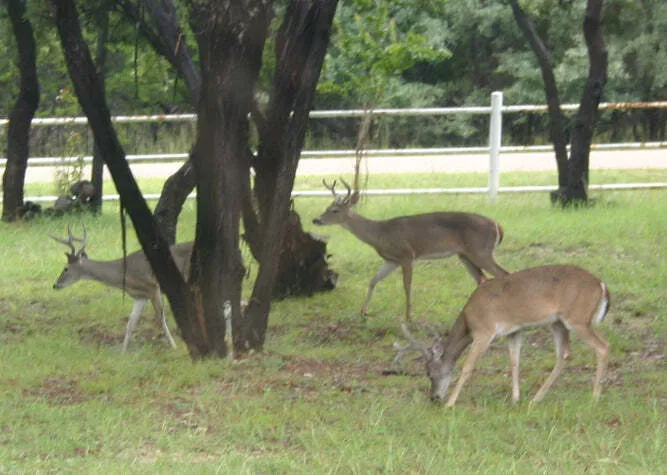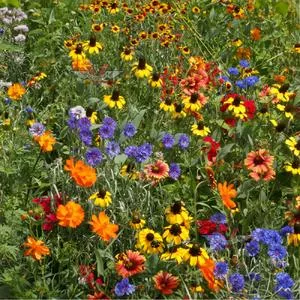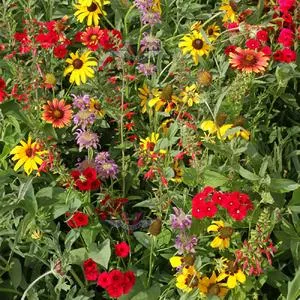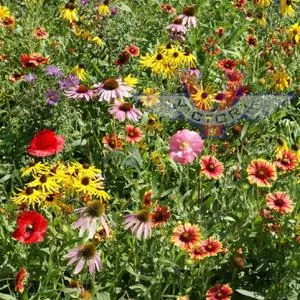Deer Resistant Wildflower Mix
Price: $4.45
SKU: 1001522Choose a variant:
Although it is fun to watch deer in nature, the old saying of "not in my backyard!" often applies to us gardeners. Most of us plant a landscape to enjoy, and a garden to provide fresh produce for our table. Having deer use our yards as their restaurant is not something we generally appreciate. This wildflower mix is a blend of various flowering plants that are known to repel deer. It is a beautifully colorful mixture of annual and perennial flowers that deer will not normally eat.
Designed to bloom all growing season long, the annual plants will bloom the first year, some will reseed themselves and reappear, and the perennial plants will become established and bloom from the second year onward.
The mix includes the following annual and perennial varieties: Yarrow (Achillea millefolium), Columbine (Aquilegia caerulea), Bachelor Buttons (Centaurea cyanus), Shasta Daisy (Chrysanthemum maximum), Godetia (Clarkia amoena), Lance Leaf Coreopsis (Coreopsis lanceolata), Larkspur (Delphinium consolida), Foxglove (Digitalis purpurea), Purple Coneflower (Echinacea purpurea), California Poppy (Eschscholzia californica), Blanketflower (Gaillardia aristata), Candytuft (Iberis umbellata), Gayfeather (Liatris spicata), Perennial Lupine (Lupinus perennis), Lemon Mint (Monarda citriodora), Red Shirley Poppy (Papaver rhoeas), Mixed Shirley Poppy (Papaver rhoeas), Red Prairie Coneflower (Ratibida columnifera), Yellow Prairie Coneflower (Ratibida columnifera), Black Eyed Susan (Rudbeckia hirta), Scarlet Sage (Salvia coccinea), Soapwort (Viscaria occulata).
Designed to bloom all growing season long, the annual plants will bloom the first year, some will reseed themselves and reappear, and the perennial plants will become established and bloom from the second year onward.
The mix includes the following annual and perennial varieties: Yarrow (Achillea millefolium), Columbine (Aquilegia caerulea), Bachelor Buttons (Centaurea cyanus), Shasta Daisy (Chrysanthemum maximum), Godetia (Clarkia amoena), Lance Leaf Coreopsis (Coreopsis lanceolata), Larkspur (Delphinium consolida), Foxglove (Digitalis purpurea), Purple Coneflower (Echinacea purpurea), California Poppy (Eschscholzia californica), Blanketflower (Gaillardia aristata), Candytuft (Iberis umbellata), Gayfeather (Liatris spicata), Perennial Lupine (Lupinus perennis), Lemon Mint (Monarda citriodora), Red Shirley Poppy (Papaver rhoeas), Mixed Shirley Poppy (Papaver rhoeas), Red Prairie Coneflower (Ratibida columnifera), Yellow Prairie Coneflower (Ratibida columnifera), Black Eyed Susan (Rudbeckia hirta), Scarlet Sage (Salvia coccinea), Soapwort (Viscaria occulata).
Planting Instructions: As early in the spring as possible, prepare your flower bed site by removing weeds and loosening the soil. You can sow the seeds by broadcasting and then raking them into the soil. The goal is for the seeds to make good soil contact and to be covered with light soil no more than two-and-a-half times their thickness. Germination will start occurring when the soil reaches about 55ºF. The area will need to be kept moist until germination occurs.
Customer Reviews:
Do you have experience with this one? 📝 📣 Write a review!
No reviews have been posted yet.





